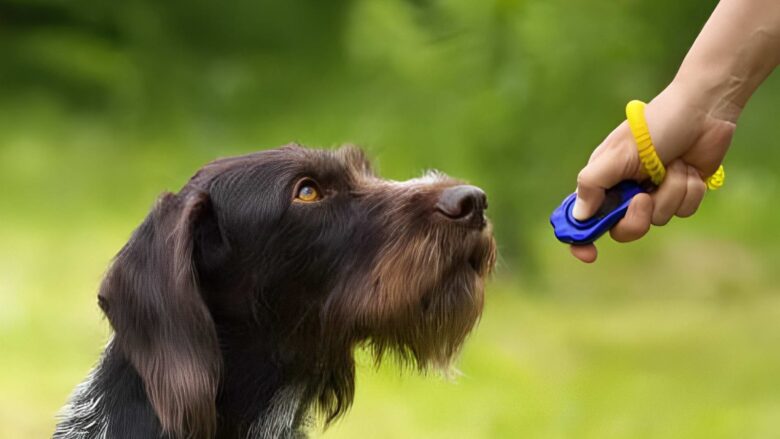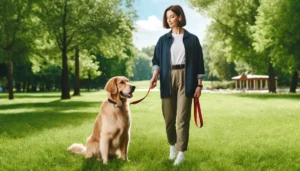Clicker training is a great way to train your dog using positive feedback. Based on the idea of operant conditioning, this training method helps owners and dogs form a strong bond. A clicker is a small, portable device that makes a distinct clicking sound. It is used as a way for trainers and dogs to communicate and quickly highlight desired behavior. In this detailed guide, we discuss where clicker training comes from, how it works, and how we can use it in real-world situations, focusing on how it can help people and their dogs get along better.
Table of Contents
Toggle1. Sources of Clicker Training:
- Historical background: The idea of operant conditioning was first developed in the early 20th century by scientist B.F. Skinner. This is where clicker training begins. Skinner’s important work has allowed us to understand how rewards and punishments change behavior. In the world of dog training, clicker training is based on the ideas he developed.
- Evolution of Clicker Training for Dogs: Whistles were first used by marine mammal trainers in the 1940s to get dolphins and other marine animals to do as they were told. Later this idea was used to train dogs, but instead of a whistle, a clicker was used because it produced a clear sound that did not change. A well-known animal behaviorist, Karen Pryor, was a major contributor to the popularity of dog clicker training in the 1990s. Her book Don’t Shoot the Dog! ‘ is an important work that brings this idea to more people.
2. Basics of Clicker Training:
- Rewards and compliments: Positive feedback, or rewarding your dog when he does something you want, is an important part of clicker training. The clicker tells the dog that a reward is coming, which is called a conditioned reinforcer. This positive association makes dog training fun, making the dog more likely to do the right thing again.
- As for time and accuracy: Timing is very important to the effectiveness of clicker training. The most important thing is that the clicking sound occurs when the dog does what you want. This makes the connection between action and hospitality clear. This direct feedback lets the dog know which action is rewarded, which means he learns faster.
- Be consistent: Consistency is very important in clicker training. The clicker should always mark the desired behavior and this should be rewarded immediately. Inconsistency can make things difficult to understand and slow down the learning process. Well-timed clicks and rewards can strengthen the link between behavior and good results.
3. Getting Started with Clicker Training:
- Prepare your clicker: It is important to teach your dog the benefits of a clicker before teaching him a specific command or behavior. It’s as easy as clicking your finger and giving your dog a few treats at a time. This trains the dog to see the clicker as a signal that something is coming.
- Brief explanation: Once the dog knows that the clicker brings a treat, you can teach him simple commands. Clicker training can be used to strengthen simple movements such as sit, stay, and come. The click indicates that the dog has accomplished what you want him to do, and a reward is a reward.
- Shaped behavior: Clicker training can help develop more complex habits by rewarding smaller steps toward a goal. So if a trainer wants to teach a dog how to retrieve an object, he can click and praise the dog for first showing interest in the toy, then touching it, and finally picking it up and bringing it back.
4. More Advanced Applications for Clicker Training:
- Problem-solving and behavior change: Dogs with social problems can be trained using clicker training. By rewarding good habits, you can turn bad habits into good ones. For example, a dog that barks too much can be trained to associate silence with a click and subsequent treat.
- Agility training: Many people use clicker training to teach their dogs agility. The time and accuracy required in agility courses are very similar to the idea behind clicker training. The trainer can help the dog avoid obstacles quickly and correctly by clicking at the right time and rewarding the dog.
5. Challenges and Considerations:
- Make assumptions: The need to generalize is one of the most difficult parts of clicker training. When dogs learn certain behaviors, they may find it easy in one environment but difficult in others. To ensure that the dog can apply the skills learned, the trainer must slowly add distractions and different environments.
- Timing Issues: Some coaches, especially new ones, find it difficult to maintain perfect timing. If you don’t use it for the same amount of time each time, it can confuse the dog or worsen bad behavior. This problem can be solved by regular practice and comments from experienced trainers.
Conclusion
Clicker training for dogs has been proven to be a flexible and safe way to encourage good behavior and strengthen the bond between parent and dog. Dog trainers can get the best out of their dogs by understanding the concepts, mastering the techniques, and applying the method consistently. Clicker training is a new and growing field that adds to the knowledge of dog training. It’s a friendly and helpful way to talk to our four-legged friends.
FAQs
1. How do you use a clicker to train your dog?
Clicker training is a method of training dogs that uses positive feedback and is based on the idea of operant conditioning. It involves using a hand-held device called a clicker to mark and reward the dog for doing what the trainer wants him to do. This creates a strong bond between the teacher and the dog.
2. How did the idea of using clickers to train dogs come about?
At the beginning of the 20th century, psychologist B.F. Skinner proposed the idea behind operant conditioning, which was the origin of clicker training. This method originated from teaching marine mammals in the 1940s, but the whistles were replaced with clickers. An animal behaviorist named Karen Pryor was instrumental in the popularity of clicker training in the 1990s.
3. What is the main idea behind using clickers for teaching?
Clicker training works best when you use positive feedback, time it just right, and be consistent. Positive feedback means you give a reward to those who behave the way you want them to after clicking the mark. It is very important to make the clicking sound immediately when the dog does what you want. Labeling and praising behavior the same way every time strengthens the link between behavior and good results.
4. How do I start training with a clicker?
First, teach the dog that the clicker means food by using it repeatedly and then give him the treat immediately. Once you’ve connected, use simple commands like “sit,” “stay,” and “come.” Click to highlight the action you want your dog to perform and reward your dog immediately.
5. Can clicker training be used for more complex tasks?
Yes, clicker training is flexible and can be used for more advanced work such as problem-solving, behavior modification, and agility training. Rewarding repeated approaches can help shape complex behavior and is useful in dealing with a wide range of behavioral problems.
6. Are there any problems with clicker training?
One problem that may arise is the need for generalization. Dogs can find it difficult to apply learned habits in different situations. Some teachers also find it difficult to manage their time precisely. These problems can be solved with regular practice and comments from experienced trainers.


